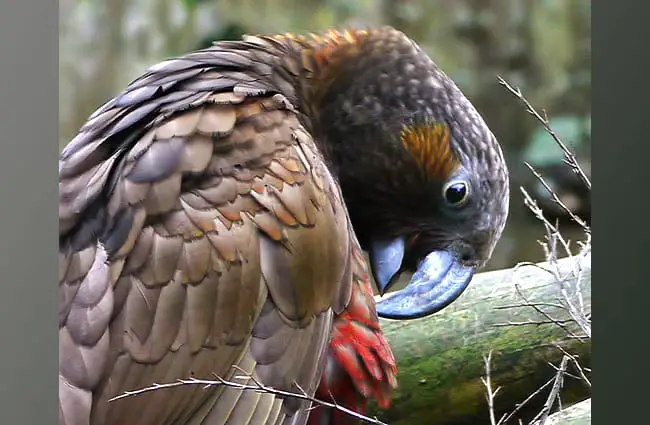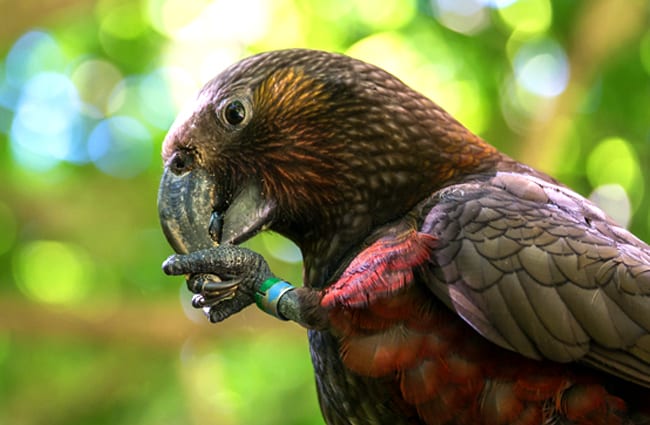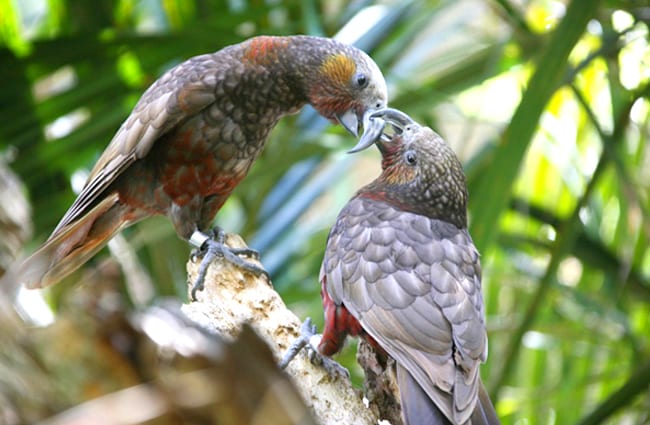The Kaka, also known as the New Zealand Kaka, is a species of parrot that lives on the island of New Zealand. Their populations live in patches across North Island, South Island, and on Stewart Island.
This species is a close relative of the Kakapo and the kea, both of which also reside in New Zealand. Read on to learn about the Kaka.
Description of the Kaka
Like most parrots, Kakas have relatively stout bodies and strong, curved bills. Their plumage, or feathers, is brownish-grey. The feathers on their underbellies and the napes of their necks are reddish-grey, and they have yellowish-grey patches on their cheeks. This species measures about 1.5 feet long and usually weighs around a pound.
Interesting Facts About the Kaka
These birds are incredibly unique, even among the immense diversity of other parrot species. Learn what makes the Kaka so interesting below.
- Ancient Ancestors – If you look at the Kaka, kea, and Kakapo, you might notice that these birds look a little different from other parrots. This is because their family, the Strigopidae family, separated from the rest of the parrots millions of years ago.
- Kaka Kakapo vs. Kea – Even though they are closely related, it’s really quite easy to tell the three cousins apart. The Kakapo cannot fly, and is much larger than the Kaka. The kea is not flightless, but its plumage has more of a green hue to it, and it lacks the reddish underside of the Kaka.
- Precarious Populations – All three species stand in a precarious position in terms of population density. Habitat destruction and hunting drove these birds to the brink of extinction, and invasive species have only added to that pressure. The IUCN lists this bird as Endangered.
- Arboreal Avians – Of the three parrot species in their family, Kakas are the most reliant on trees, as this is the only place it finds food. By contrast, the Kakapo and the kea both forage on the ground. They all eat fruits, seeds, berries, nectar, and some insects and insect larvae.
Habitat of the Kaka
This species only lives in forested habitats. They inhabit areas at sea level as well as some mountainous regions. These birds often inhabit small islands offshore as well. However, their populations are most successful in sanctuary areas where people remove invasive predators.
Distribution of the Kaka
Kakas live in small regions of forest across portions the North Island and South Island of New Zealand. Their strongest populations live in sanctuary areas and reserves.
Some of these reserves include Little Barrier Island, Kapiti Island, Codfish Island, Hen Island, Chicken Island, Ulva Island, and more. On the mainland, they inhabit Kahurangi National Park and Fiordland National Park.
Diet of the Kaka
These birds are omnivorous, and they eat both plants and invertebrates. Most of their diet comes from fruits, seeds, flowers, nectar, and other plant parts. They also feed on insect larvae, primarily the huhu beetle. Kakas use their beaks to pull bark off of trees to find and eat the grubs.
While foraging, they move from food source to food source. Because of this, their diet changes from season to season as different plants produce flowers, seeds, and fruits.
Kaka and Human Interaction
Though humans do not directly threaten these birds anymore, human activity has decimated the populations of these birds. Historically, people have cleared their forest habitats and hunted these birds and their eggs. They also introduced invasive animals that hunt the Kaka, eat their eggs, and compete with them for food.
The IUCN lists this species as Endangered, and classifies their populations as decreasing. However, conservation projects are creating sanctuaries for these birds and removing predators from nesting sites. This is helping their populations recover.
Domestication
Humans have not domesticated the New Zealand Kaka in any way.
Does the Kaka Make a Good Pet
No, these birds do not make good pets. Every single individual is important for the survival of the population. For this reason, it is illegal to own a Kaka as a pet.
Kaka Care
Very few zoos keep this species. Those animals that do live in zoos usually live in pairs in an attempt to produce a breeding population. If zoos could establish a breeding population, then they could reintroduce birds into the wild to bolster their numbers.
In zoos, these birds receive similar care to other parrot species. Their enclosures are large enough to fly and exercise, and contain plenty of branches and vines to climb and fly to. Zookeepers feed them fruits, seeds, berries, commercial parrot diet, and insects.
Behavior of the Kaka
These birds are usually diurnal, or active during the day. They spend almost all their time high in the trees foraging for food. Within the forest, they live in the canopy or the very tops of the trees. The canopy is very dense, so they are quite skilled at flying in between branches and vines.
Their social behavior varies based on the individual. Though they often congregate in groups, known as flocks, it is not unusual for them to forage alone as well. Large flocks frequently convene on a prolific food source, like a fruiting tree.
Reproduction of the Kaka
Most pairs only produce one clutch, but some birds breed twice in a single year. They build their nests in tree cavities, and most clutches contain about four eggs. Females perform all incubation duties, but the male feeds her while she keeps the eggs warm.
Once the eggs hatch, it takes about two months for the chicks to learn how to fly. The chicks are completely helpless when they hatch, and the mother has to brood them to keep them warm. During this time the father continues feeding her and the chicks.













![Red Angus Closeup of a beautiful Red Angus cowPhoto by: U.S. Department of Agriculture [pubic domain]https://creativecommons.org/licenses/by/2.0/](https://animals.net/wp-content/uploads/2020/03/Red-Angus-4-238x178.jpg)












![Red Angus Closeup of a beautiful Red Angus cowPhoto by: U.S. Department of Agriculture [pubic domain]https://creativecommons.org/licenses/by/2.0/](https://animals.net/wp-content/uploads/2020/03/Red-Angus-4-100x75.jpg)

